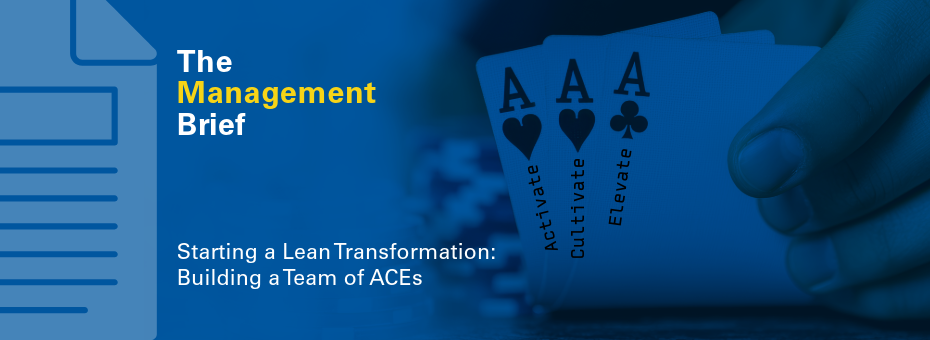Lean transformations don’t happen by accident—or by hiring a consultant to drop a playbook and walk away. At a newer Midwest manufacturing plant with which we’ve been partnering, we’ve seen firsthand that sustainable change starts with people: a team of ACEs—individuals we activate, cultivate, and elevate. This isn’t just a nice-to-have; it’s the backbone of any organization serious about a step change in performance. Whether you’re stamping car components, processing beverages, developing software, or managing a supply chain, here’s why building a team of ACEs is critical—and how to do it right.
Coaches vs. Consultants: The Difference Matters
A consultant might tell you what to do, but a coach? A coach demands a learner—someone ready to roll up their sleeves, get curious, and do the work. We often say, “We learn by doing, not explaining.” The faster you get to the gemba (the shop floor, where value is created), the quicker real coaching and learning kick in. According to the Lean Enterprise Institute, “Kaizen is a human-centered approach,” and that human element starts with a coach and a team willing to experiment. Jim Womack, a lean pioneer, emphasizes this in Gemba Walks, noting that “Real learning comes from seeing the work where it happens.”1
A consultant might tell you what to do, but a coach? A coach demands a learner—someone ready to roll up their sleeves, get curious, and do the work.
So, as a leader or manager, when your coach arrives and says, “Help me build a team of ACEs,” you’re likely to ask, “What is an ACE?” and “What do you want from me?” Humility tops the list—egos kill progress. Add basic math and drawing skills (think eighth-grade level), curiosity, and a willingness to get your hands dirty (not leadership skills you’d probably list on your resume). You’re not creating superheroes; you just want your frontline workers, supervisors, and engineers ready to become something more.
Step 1: Activate
Activation is about creating the spark. Introduce your team to the basics: value-added vs. non-value-added (NVA) and the seven (or eight, depending on who’s counting) types of waste. Hand them a stopwatch, point them to the gemba, and let them observe. Questions will bubble up fast—”Why does this step take so long? Why are we moving parts twice?” Nudge them toward small kaizen experiments: quickly simulate an improvement, tweak a process, kaizen a baby step, try something and see if it works. Once their eyes open to waste, the doors of kaizen swing wide. You’ve got an activated ACE.
Step 2: Cultivate
Cultivation isn’t a hunt for quick wins, it’s farming—deliberate and observant. Coaches and learners need to study the “soil” of the shop floor: What’s the process? What’s the condition? What’s unique here? Organizations often want to skip this step, copy-pasting a single solution across operations or mimicking something found in another organization. But lean isn’t one-size-fits-all. Blanket fixes might yield short-term gains, but without truly understanding the current state specific to a process and considering solutions tailored to that situation, you’re setting up ACEs for frustration and minimizing their options for improvement and for developing their true potential.
Lean is about developing people through problem-solving, not just fixing processes.
In cultivation, the learner engages the shop floor and the people doing the work there, the coach provides guidance, and through their collaboration they achieve growth. We’ve seen this play out as teams study the operation, drive kaizen to remove waste, and arrange the work to fit the current takt rather than slapping a generic fix everywhere. It’s messy, it’s hands-on, and it works. John Shook, co-author of Learning to See, reinforces this: “Lean is about developing people through problem-solving, not just fixing processes”.2
Step 3: Elevate
Here’s where senior leaders earn their keep—or drop the ball. Elevation isn’t just slapping a gold star on someone’s badge. If leaders aren’t at the gemba, observing the work and understanding it, they won’t know who to elevate or why. Recognition alone isn’t enough; elevated ACEs need challenges—mentoring others, sharpening their kaizen skills, tackling bigger problems. You’re not awarding others for hitting objectives but for how they hit those objectives.
We’ve watched activated and cultivated ACEs step up to lead daily huddles or propose layout changes that save hours. Leaders need to be brave and free the space so ACEs can elevate, sometimes stumbling along the way; those who don’t miss the point: lean thrives when team members grow, not when the C-suite claps.
The Bottom Line
Building a team of ACEs isn’t optional—it’s how lean transformations stick. For management everywhere, from our partners to the broader marketplace, the message is clear: invest in your people, not just your processes and equipment. Activate them with tools and curiosity, cultivate them through coaching and study, and elevate them with real responsibility. That’s how you turn a plant—or any operation—into a lean powerhouse.
Welcome to The Management Brief — a weekly newsletter from the Lean Enterprise Institute delivering actionable insights, strategies, and stories on lean management. Each issue explores proven methods like hoshin kanri for strategic alignment, A3 problem-solving, and daily management that foster stability, improvement, and innovation. We aim to help you build resilient, high-performing organizations prepared for long-term success. Subscribe for free and join a community dedicated to management excellence.
1 James P. Womack, Gemba Walks. Lean Enterprise Institute. Available at https://www.lean.org/store/books/.
2 John Shook and Mike Rother, Learning to See. Lean Enterprise Institute. Available at https://www.lean.org/store/books/.
The Lean Management Program
Build the capability to lead and sustain Lean Enterprises





Tyson, I’m Totaly agree with your point of view. Get involved to the Supervisor and engineers working together with personas that run the floor, watchig how is the line running , kpi etc define the kaizen activities to attack the MUDAS and show results , before and after and the beneifts will take the plant to be a world class manufacturing facility.